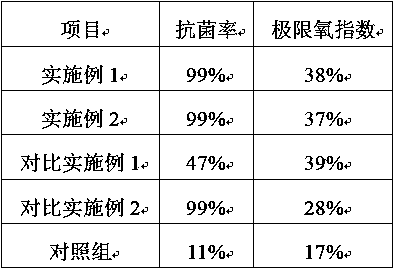Method for processing fibers for wig
A treatment method and wig technology, which is applied in the field of wig treatment, can solve problems such as life-threatening safety, environmental pollution, and flammability, and achieve the effects of improving flame retardant effect, antibacterial performance and polymerization degree, and antibacterial performance.
- Summary
- Abstract
- Description
- Claims
- Application Information
AI Technical Summary
Problems solved by technology
Method used
Image
Examples
Embodiment 1
[0025] A method for treating fibers for wigs, characterized in that it comprises the following steps, and the following raw materials are calculated in parts by weight:
[0026] (1) Pineapple leaf degumming process:
[0027] Add sulfuric acid to 10 parts of pretreated pineapple leaves at a bath ratio of 1:50, pickle at 50°C for 65 minutes, wash with water, then add alkali treatment solution at a bath ratio of 1:30, and scorch at 95°C for 2 hours After washing with water, add sulfuric acid at a bath ratio of 1:20, pickle at 50°C for 20 minutes, wash with water, neutralize, wash with hot water, and wash with water in sequence, and finally dry to obtain antibacterial pineapple leaf fibers;
[0028] Among them, pineapple leaf steam flash explosion-retting combined pretreatment: cut 10 parts of fresh pineapple leaves into small pieces, put them in a steam flash explosion device, hold the pressure for 3 minutes under a pressure of 2MPa, and then retting with natural pool water at 36...
Embodiment 2
[0039] A method for treating fibers for wigs, characterized in that it comprises the following steps, and the following raw materials are calculated in parts by weight:
[0040] (1) Pineapple leaf degumming process:
[0041] Add sulfuric acid to 20 parts of pretreated pineapple leaves at a bath ratio of 1:50, pickle at 60°C for 55 minutes, then wash with water, then add alkali treatment solution at a bath ratio of 1:30, and boil at 105°C for 1 hour After washing with water, add sulfuric acid at a bath ratio of 1:20, pickle at 60°C for 10 minutes, wash with water, neutralize, wash with hot water, and wash with water in sequence, and finally dry to obtain antibacterial pineapple leaf fibers;
[0042] Among them, pineapple leaf steam flash explosion-retting joint pretreatment: cut 20 parts of fresh pineapple leaves into small pieces, put them in a steam flash explosion device, hold the pressure for 4 minutes under 2MPa pressure, and then retting with natural pool water at 38°C P...
PUM
| Property | Measurement | Unit |
|---|---|---|
| carbon residual rate | aaaaa | aaaaa |
| elongation at break | aaaaa | aaaaa |
Abstract
Description
Claims
Application Information
 Login to View More
Login to View More - R&D
- Intellectual Property
- Life Sciences
- Materials
- Tech Scout
- Unparalleled Data Quality
- Higher Quality Content
- 60% Fewer Hallucinations
Browse by: Latest US Patents, China's latest patents, Technical Efficacy Thesaurus, Application Domain, Technology Topic, Popular Technical Reports.
© 2025 PatSnap. All rights reserved.Legal|Privacy policy|Modern Slavery Act Transparency Statement|Sitemap|About US| Contact US: help@patsnap.com

